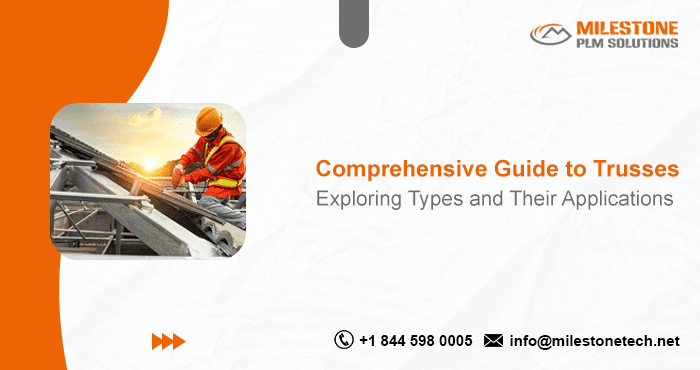Comprehensive Guide to Trusses: Exploring Types and Their Applications

Understanding Trusses
A truss is a structural framework composed of interconnected triangular units. This configuration makes trusses incredibly strong and efficient in supporting loads over long spans. They are widely used in construction for roofs, bridges, and other structures where strength and economy are paramount.
The triangular shape of a truss is crucial to its strength. A triangle is the only rigid shape in two dimensions, meaning it cannot deform without changing the length of its sides. This property ensures that the forces applied to a truss are distributed evenly throughout its members, maximizing its load-bearing capacity.
Types of Trusses
There are several types of trusses, each designed to meet specific structural needs. This guide to trusses categorizes them based on their shape and the materials used.
- King Post Truss : The King Post Truss is one of the simplest forms of trusses, featuring a central vertical post (the king post) and two diagonal members. It is ideal for short spans and is commonly used in residential buildings, small bridges, and simple roof structures.
- Queen Post Truss : Similar to the King Post Truss, the Queen Post Truss has two vertical posts (queen posts) instead of one. This design allows for longer spans and greater load-bearing capacity. It is often used in larger residential and commercial buildings, as well as in bridges.
- Howe Truss : The Howe Truss consists of vertical and diagonal members that form a series of triangles. It is particularly strong in resisting compressive forces and is widely used in bridges, railway structures, and large roof systems.
- Pratt Truss : The Pratt Truss features diagonal members that slope towards the center of the truss under tension and vertical members under compression. This design is efficient for longer spans and is commonly used in bridges and industrial buildings.
- Warren Truss : The Warren Truss is characterized by its equilateral triangles, creating a structure with equal compression and tension. This type of truss is popular in bridge construction and buildings requiring large, open spaces without intermediate supports.
- Fink Truss : The Fink Truss is widely used in residential roof construction. It has a W-shape configuration, providing excellent support for roof loads and allowing for the creation of attic spaces.
- Scissor Truss : The Scissor Truss is designed to create vaulted ceilings. Its members intersect in a way that allows for greater headroom and architectural aesthetics, making it popular in churches, halls, and modern homes.
Applications of Trusses
Trusses find applications in a wide range of structures:
- Residential Construction: Roof trusses are the backbone of modern homes, providing support for the roof while maximizing interior space. They come in various designs to accommodate different roof pitches, attic layouts, and architectural styles.
- Commercial and Industrial Buildings: Trusses are extensively used in warehouses, factories, and other large-scale structures. They offer long spans, high load-bearing capacity, and flexibility in design to meet specific functional requirements.
- Bridges: Truss bridges are iconic structures known for their strength and durability. They can span long distances and support heavy loads, making them ideal for both road and railway transportation.
- Roof Structures: Beyond residential applications, trusses are employed in various roof structures, including stadiums, arenas, and exhibition halls. They create open spaces with minimal obstructions, providing flexibility for various events and activities.
- Other Structures: Trusses can also be found in other structures like towers, cranes, and agricultural buildings, where their strength and efficiency are essential.
Advantages of Trusses
The guide to trusses wouldn’t be complete without highlighting their advantages:
- Strength and Stability Trusses are incredibly strong and stable due to their triangular configuration. This design ensures that loads are evenly distributed, reducing the risk of structural failure.
- Material Efficiency Trusses require less material compared to traditional framing methods, making them cost-effective and environmentally friendly. The efficient use of materials also reduces construction time.
- Versatility Trusses can be customized to fit various architectural designs and structural needs. They are adaptable to different materials, spans, and load requirements.
- Ease of Installation Prefabricated trusses can be manufactured off-site and quickly installed on-site, reducing labor costs and construction time. This ease of installation makes them a preferred choice in modern construction.
Conclusion
Trusses are indispensable structural elements that have revolutionized construction. Their ability to efficiently distribute loads, create open spaces, and provide cost-effective solutions has made them a preferred choice for engineers and architects worldwide. Understanding the different types of trusses and their applications is crucial for making informed decisions in construction projects. By carefully selecting the appropriate truss design, builders can achieve structures that are both strong and aesthetically pleasing.
Follow Milestone PLM Solutions for AEC Industry Updates, CAD Tips and Global Construction News.
Milestone PLM Solutions with its exclusive delivery center in India is a global CAD, BIM outsourcing partner serving the needs of the AEC industry since 2004. MILESTONE focuses on the unique needs of clients and believe in tackling real-life problems with efficiency, smooth and ease.
The MILESTONE team can assist you with DD Set, CD Set, BIM Modeling, Rendering, walk through and more. We support multiple BIM software including AUTOCAD REVIT, Architecture cad, Cabinet Vison, Vector works etc. Our approach is to provide a dedicated team for each customer over ongoing project and deliver the quality output consistently.
With our state of art technology and large talent pool of Engineers & Architects, we are developing best in class solutions for our customers across the globe. We align with your culture and values to form unbreakable partnerships and are primed for success with over 100 employees and 150 customers in the US, Europe, India, and Asia.
You can email us at info@milestonetech.net and can log in to our website www. milestonetech.net to know more about our services and our work portfolio or contact us on +1-844-598-0005
